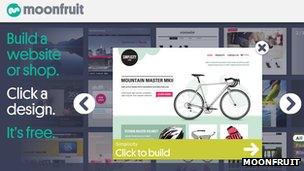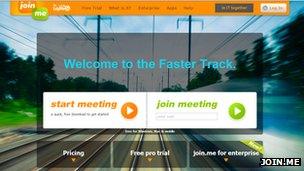Tech tonic: Reboot your profits with a digital makeover
- Published

Is old technology preventing your business from blasting off to the stars?
Is your website duller than a wet weekend in Margate? Your presentations drier than dog biscuits? Your back office a shambolic paper mountain?
Then you need a digital makeover to get your business match fit for the 21st Century. And giving your business a tech tonic can boost turnover and profits surprisingly quickly.
Research from the Federation of Small Businesses (FSB) suggests firms spending just £2,700 on average to update their hardware - desktops, mobiles, printers and the like - saw their turnover and profits rise 35% after a year.
Firms spending the same amount on software enjoyed a near-40% boost to their bottom lines.
"Investing in technology drives business efficiency, gives you a better understanding of your customers, drives innovation, and improves turnover and profits", says FSB spokesman Priyen Patel.
So where do you start?
'Compelling content'
The website, stupid. It is your shop window to the world, after all. But shockingly, about 20% of UK businesses still don't have one, according to Eurostat, let alone a good one.
This is despite the fact that the UK has risen to third (from fifth) in the latest Global Innovation Index published by INSEAD, the European Business School, Cornell University, and the World IP Organisation.
Nic Howell, planning director for LBi, a marketing and technology agency that counts Coca-Cola, Barclays and Virgin among its client list, says: "Your customers expect you to be online these days at an easy-to-navigate website.
"They also expect to find you on Facebook and to be engaging with them on Twitter. It's a very brave business that doesn't do any of these things."
And the proliferation of networked gadgets means your customers expect to be able to interact with you via any device they choose.
But old websites often have not kept up with the pace of technological change.
Dan Simmons web designer with River-Digital, says: "Older websites are not always compatible with the latest web browsers or easily viewable on mobile devices, so businesses need to update them.
"For example, sites built using Adobe Flash aren't viewable on Apple devices, such Macs, iPads and iPhones, and Google Android is no longer supporting Flash either", he says.
"These days a website has to be responsive, which means capable of being viewed and adapted to mobile devices as well."
In-browser design

HTML5 website builders, such as Moonfruit, make setting up a cross-platform website easy
The latest versions of programming languages, such as HTML5, CSS and JavaScript, herald a new era of in-browser development tools that make it much easier to create websites that are accessible across all platforms and devices.
Simple, template-based website builders, such as Moonfruit.com, offer HTML5 designs for free if you have Moonfruit in the web address, or non-branded services from £8 to £25 a month. Wix.com offers a similar easy-to-build HTML5 website service.
Popular content management systems, such as WordPress, Joomla and Drupal, help organise your websites, and because they are open-source it means you are far more likely to find a plug-in programme from the developer community that will give your site even more functionality and pizzazz.
And in-browser website development tools from the likes of Typecast are helping to make website design easier, while PayPal makes the whole business of online card payment processing a doddle.
High-definition

A well-made video, like this 2013 Webby Award-winner from the John F Kennedy Museum, can boost your reputation
Many companies include video as way of explaining what they do in an entertaining way. With high-definition video cameras falling in price, and the likes of Vimeo and YouTube simplifying embedding video in websites, adding multimedia interest to your website has never been easier.
"It can be a great way of telling your company's story in a short space of time," says Dan Simmons.
It should almost go without saying that consumer-facing businesses should have Facebook pages and Twitter feeds as a way of engaging with their customers.
"You need to invest in human capital as well," says RJ Bhalla, professor of innovation management at the Cass Business School.
"This means changing the behaviour of employees, developing their IT skills and making sure messages are consistent across all channels."
Screen-sharing

Online screen-sharing services have made business collaboration cheap and easy
While there will always be a place for the face-to-face meeting and a good deal-clinching lunch, most of the time online interaction makes sense, especially if you trade internationally.
Collaboration software and video conferencing has been around for years, offered by companies such as WebEx and GoToMeeting, but it used to be quite clunky and aimed at big business.
Now browser-based screen-sharing applications, such as JoinMe, are making online meetings simple and quick to arrange, while Skype has brought video conferencing into the reach of even the smallest businesses.
After registering with JoinMe, all you need to do is download a small JavaScript applet to initiate the meeting. The participant types the JoinMe web address including your profile name or a one-off code number into their web browser and then they can see everything on your screen.
It is so easy to set up you could be showing a potential client your latest Powerpoint presentation, video or design ideas within a matter of minutes without having to interrupt your telephone conversation.
Back office

If your back office looks like Bletchley Park circa 1940, it is probably time to upgrade
Talking of those Powerpoint presentations, if you're still regurgitating text-only slides word-for-word, you probably deserve to go bust.
There's no excuse for boring business cards either, now that online printing firms such as Moo.com are offering NFC (Near Field Communication) cards containing a small microchip.
Simply touch an NFC-compatible smartphone with the card and it will download whatever digital files you want it to - your portfolio, music, video, website, or simply your contact details.
But the FSB's Priyen Patel reminds businesses to apply a digital makeover to their back offices as well as their customer-facing parts.
"Improving your back office processes - is one of the best things businesses can do to improve productivity," he says.
All these technological developments have certainly lowered the barriers to entry into the global business big league for many smaller businesses.
But LBi's Nic Howell concludes: "Using the latest technology is important, but even more important is the quality of your business and the story you want to tell."